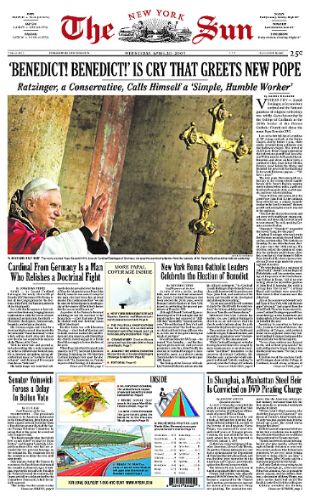2005 April
About Andrew Cusack
 Writer, web designer, etc.; born in New York; educated in Argentina, Scotland, and South Africa; now based in London.
Writer, web designer, etc.; born in New York; educated in Argentina, Scotland, and South Africa; now based in London. read more
News
Blogs
Reviews & Periodicals
Arts & Design
World
France
Mitteleuropa
Knickerbockers
Argentina
The Levant
Africa
Cape of Good Hope
Netherlands
Scandinavia
Québec
India
Muscovy
Germany
Academica
Well Hurrah!
Today I:
1. Practically wrote an entire essay in one day and handed it in and I think it was pretty good. I know, that’s nothing special, but I’ve never done it before, and it took up the preponderance of the day.
2. Went to a celebratory birthday brunch for Maria.
3. Participated in the Second Annual Bumblebee Hunt held under the auspices of the St Andrews branch of the Sons of Confederate Veterans. The winning bumblebee was a big one, which was christened Algernon Deathbee. He will be tied to a string which will be tacked to a table at the Officer Training Corps Ball tonight. (I am not attending).
4. Managed to fit in a walk on the beach with Lizzy and Nicholas.
Next on the agenda… get a bit of research done for the next essay, then out for dinner and drinks at the Jigger for Maria’s birthday, then hopefully get started on the speech I have to give at a dinner tommorrow night.
The Charity Polo is tommorrow, and it looks like it’s going to be a beautiful day, but I’m not sure if I’ll go. Vichy France looms on the horizon, and I’ve got the hush-hush dinner in the evening to boot.
Oh fiddlesticks, I’ve forgotten to return these short loan books. Got to run.
The Holy Father’s Installation

Deo gratias!
Taki on the Sun

In this week’s Spectator, the ‘poor little Greek boy’ Taki informs us of a feud between the Dorothy Parker Society and the F. Scott Fitzgerald Society. Apparently the DPS invited the FSFS to a big to-do at the Algonquin and the FSFS didn’t even respond. “I get all this info from my favourite Big Bagel paper, the Sun, or the Sharon, as I call it, because of the line it follows where Israel is concerned.” I love the Sun, and I’m very glad Taki has discovered our favorite New York daily. He continues:
Benchley, like Parker, was a founding member of the Algonquin round table, and was known to have spilled more booze than F. Scott ever downed. Unlike the latter, he could hold it. Emerging once from the Waldorf Astoria, he commanded a doorman to get him a taxi. ‘How dare you, Sir,’ came the answer. ‘I am a United States admiral.’ ‘Well, in that case,’ said the well-oiled Benchley, ‘get me a battleship.’
Moving along…
I have not read his book, which is coming out sometime next year, but press reports have it that he was delighted by what he discovered. His accounts apparently have no condescending references to the kitsch or to materialism, which so many of us Europeans refer to every time we write about or mention America. That’s because he went to places like Cooperstown, New York, where the baseball hall of fame museum is located, or to Pennsylvania, among the Amish. (Not much materialism among that lot, that’s for sure.) And a poignant moment, when he is accosted by a Michigan policeman and told to stop loitering and to keep moving — BHL is relieving himself in a field — and he informs the cop that he’s a Frenchman and that he’s following Tocqueville’s footsteps, which results in a pleasant conversation.
Yes, Americans are nice people who want to be nice and do not understand why the Europeans hate them so. Our own Paul Johnson explained it all some weeks ago when he said that, if he were younger, he’d move to the land of plenty. Sure, manners are not an American strong point, nor is its taste for music and movies. But the natives are friendly, vulgar and nice, which is a lot more than I can say for some of us from the old continent.
I seem to have misplaced or thrown out (shudder!) the Speccie with Paul Johnson’s salient words urging and young people with talent in Britain to move to America, but if I do find it, I shall post his words of hope.
Grant’s Tomb
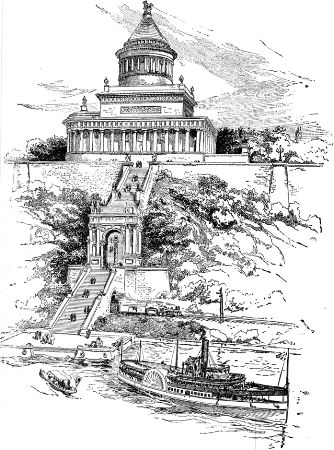
I came across this illustration of the original plan for Grant’s Tomb in Riverside Park on the Upper West Side, back home in New York. The differences are conceptually slight, except for the complete lack of this grand staircase and triumphal arched watergate on the Hudson River, which was never constructed. It would be an intriguing addition if built, but I think slightly awkward, as it leads up to the side of the mausoleum, rather than the front. Had the tomb been constructed with its orienation towards the Hudson rather than on the axis of the long Riverside Park, it might be sucessful, but otherwise, it was wise of the city fathers not to execute this part of the plan.
For more views of Grant’s Tomb, see the Bridge and Tunnel Club’s page.
‘The Pope: A Portrait from Life’
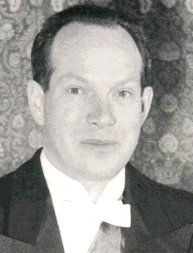 LAST NIGHT I finished reading ‘The Pope: A Portrait from Life’ by Constantine, Prince of Bavaria, about Pope Pius XII (who I thought had already been beatified, but not yet). It is definitely one of the biographies I have most enjoyed, perhaps even most enjoyed. The book’s strength lies not in academic depth nor in attention to detail but in giving the reader a great insight into the great man who Pius XII was. From his brilliant diplomacy, working for peace during the First World War under Pope Benedict XV, warning of the dangers of National Socialism as nuncio to Germany under Pope Pius XI, his own accession in 1939, and his tireless efforts to give shelter to all who were in need: Socialists, Communists, Jews, Christians, Atheists, Liberals, Royalists, Republicans, escaped Allied prisoners of war, and after the war, fascists, collaborators, Germans, and others whose lives (and souls) were equally in danger. There was no barrier of race or religion or party or ideology. Indeed, the Grand Rabbi of Rome, sheltered by Pius XII during the war was so inspired by him that three years after the war ended, he became a Christian, taking the name ‘Eugenio’, Pius’s birth name.
LAST NIGHT I finished reading ‘The Pope: A Portrait from Life’ by Constantine, Prince of Bavaria, about Pope Pius XII (who I thought had already been beatified, but not yet). It is definitely one of the biographies I have most enjoyed, perhaps even most enjoyed. The book’s strength lies not in academic depth nor in attention to detail but in giving the reader a great insight into the great man who Pius XII was. From his brilliant diplomacy, working for peace during the First World War under Pope Benedict XV, warning of the dangers of National Socialism as nuncio to Germany under Pope Pius XI, his own accession in 1939, and his tireless efforts to give shelter to all who were in need: Socialists, Communists, Jews, Christians, Atheists, Liberals, Royalists, Republicans, escaped Allied prisoners of war, and after the war, fascists, collaborators, Germans, and others whose lives (and souls) were equally in danger. There was no barrier of race or religion or party or ideology. Indeed, the Grand Rabbi of Rome, sheltered by Pius XII during the war was so inspired by him that three years after the war ended, he became a Christian, taking the name ‘Eugenio’, Pius’s birth name.
‘The Pope: A Portrait from Life’ tells the story of Eugenio Pacelli with anecdotes and stories from all the people surrounding this, the most lied-about figure in the history of the twentieth century. I strongly recommend this book to anyone interested in the life of Bl. Pius XII. It is almost cinematic as it moves from scene to scene, from the present (Rome 1954) to the past, in Rome, in Germany, in America over the years of Eugenio Pacelli’s career as priest, churchman, diplomat, and finally pontiff.
Constantine himself (pictured above) is interesting in his own right. Born in 1920, with all the Royal House of Wittelsbach he was kicked out of the German Army by Hitler and, in 1944, arrested by the Gestapo. Liberated by the French, he went on to work for the International Red Cross, until 1947 when he went to work in the Munich office of the Associated Press. In 1950, he became editor of Germany’s Revue magazine, and was later elected to the Bundestag. Unfortunately, he died in an air crash in 1969. This book as evidence of Contantine’s adroitness in the journalistic profession. It is no longer in print, sadly, and so hard to find, but if you do ever happen to come across it, buy it, read it; you will not be disappointed.
‘For Christ and Liberty’
Though a purely Protestant institution (literally), I am rather fond of Patrick Henry College. Indeed, it takes some courage in this day and age to only admit students willing to sign a ten-point profession of Protestant Reformed faith. They also happen to have an old-fashioned ball featuring ‘English country dancing, delicacies such as cream puffs and truffles and leisurely strolls about the scenic grounds of the historic Selma Plantation’.
Anyhow, the college, whose motto is ‘For Christ and Liberty’, was visited Anthony Esolen, a contributing editor to Touchstone magazine, who makes these comments:
That such a request came was no surprise. Its provenance is, and cheeringly so. For this De Tocqueville Society is made up of a group of students at the new Patrick Henry College, founded by Mike Farris, the President of the Home School Legal Defense Association. More than ninety percent of the college’s students were homeschooled. If there’s a Roman Catholic in the bunch, I’ve yet to hear about it, and I’ve been to that campus twice to give lectures. [Note: Esolen does not seem to be aware that PHC requires its students to be Protestant.]
More on that in a moment. I could spend all evening singing the praises of PHC (as the students fondly call it), but let me share one discovery I made that should gratify Touchstone readers. The first time I spoke there, two years ago, I was stunned to meet young men and women who—who were young men and women. I am not stretching the truth; go to Purcellville and see it for yourselves if you doubt it; I believe my wife took a couple of pictures, just to quiet the naysayers. The young men stand tall and look you in the eye—they don’t skulk, they don’t scowl and squirm uncomfortably in the back chairs as they listen to yet another analysis of Rebecca of Sunnybrook Farm, or one of the healthier poems of Sylvia Plath. They’re frank and generous and respectful, but they hold their own in an argument, and they are eager to engage you in those. They are comfortable in their skins; they wear their manhood easily. And the young ladies are beautiful. They don’t wither away in class, far from it; but they wear skirts, they are modest in their voices and their smiles, they clearly admire the young men and are esteemed in turn; they are like creatures from a faraway planet, one sweeter and saner than ours.
Two years ago I spoke to them about medieval Catholic drama. They are evangelicals, half of them majors in Government, the rest, majors in Liberal Arts. They kept me and my wife in that room for nearly three hours after the talk was over. “Doctor Esolen, what you say about the habits of everyday life—to what extent is it like what Jean Pierre de Coussade calls ‘the sacrament of the present moment’?” “Doctor Esolen, do you see any connections between the bodiliness of this drama and the theology of Aleksandr Schmemann?” “Doctor Esolen, you have spoken a great deal about our recovery of a sense of beauty, but don’t you think that artists can also use the grotesque as a means of bringing people to the truth?” “You’ve suggested to us that Christians need to reclaim the Renaissance as our heritage, yet we are told that that was an age of the worship of man for his own sake. To what extent is the art of that period ours to reclaim?” And on and on, until nearly midnight.
The questions were superior to any that I have ever heard from a gathering of professors—and alas, I’ve been to many of those. I mean not only superior in their enthusiasm and their insistence, but in their penetrating to the heart of the problem, their willingness to make connections apparently far afield but really quite apropos, and their sheer beauty—I can think of no better word for it.
A few weeks ago I was in town for another talk, on the resurrection of the body. The Holy Father had passed away. At supper, ten or fifteen of the students packed our table, to ask questions before the talk. They were reverent and extraordinarily well informed; most especially they were interested in the Theology of the Body. The questions on that topic continued after the lecture, and I had the same experience I’d had before, but now without the surprise.
And these are the young people who are devoting an entire issue of their journal to the thought of Cardinal Ratzinger, now the new head of the Roman Catholic Church. They are hungry to know about him; in the next week or two they will do what our slatternly tarts and knaves, I mean our journalists, have never done and will not trouble themselves to do, and that is to read what Benedict XVI has said, read it with due appreciation for their differences with him, and due deference to a holy and humble man called by Christ to be a light not only to Roman Catholics but to all the nations.
These students don’t know it, but in their devotion to their new school (they are themselves the guards, the groundskeepers, the janitors; they ‘own’ the school in a way that is hard to explain to outsiders), they live the community life extolled by Leo XIII in Rerum Novarum; in their steadfastness to the truth they are stalwart participators in the quest set out by John Paul II in Fides et Ratio; in their welcoming of me and, God bless them, of the good Benedict XVI, they live in the true spirit of Lumen Gentium, that greathearted document of the council so often invoked for the lame tolerance of every betrayal of the ancient faith. And for what it’s worth, they are readers of Touchstone Magazine.
Be silent, Greeleys and Dowds of the world. These young people have you whipped, if for no other reason than that they believe in the One who is Truth, and who sets us free. How can I praise these my young brothers and sisters any more highly? God bless them and Patrick Henry College. And the rest of us, let’s keep an eye on them. We’ll be seeing quite a harvest from that seedbed!
Many of the points Esolen commends are things I hope will be found in the colleges of my university when I get around to starting it. I particularly admire that Patrick Henry College’s young men and women are just that, according to Esolen. This is all too often hard to achieve in modern American higher education, where students are quite often just elderly adolescents. (Though I suspect this has more to do with parents and family than education).
The absurdist drinking age that the Federal government underhandedly coerced each state into passing hinders maturity as well. Indeed, when I start the first college or colleges of the university I’m planning, each will have a private college bar which will serve anyone over the age of 16 or so. (Probably at the barman or barmaid’s discretion). Civil disobedience is the only solution.
Though the graduates Patrick Henry College provides will be Protestant (at least at the time of their graduation), I have no doubt that they will act as leaven to raise up the social and political life of our United States. I’m not particularly fond that they proudly advertise their commendation as “One of America’s Top Ten Conservative Colleges”. I’m not of the view that colleges ought to be ‘conservative’ or ‘liberal’ per se. They ought to be seen more as communities of inquisitive, curious, intelligent people united in the quest for truth. Labels like ‘conservative’ and ‘liberal’ are far too narrow and allow the simple-minded to pidgeon-hole things which are too complex for such monikers.
But anyhow, cheers for Patrick Henry College.
Prof. Haldane on Benedict XVI
Our own Professor John Haldane, of the Philosophy Department here at St Andrews, has written a very calm and sensible commentary on the Holy Father. You can read it here. Read the whole thing through; like much of Haldane’s writing, it’s unexciting but informative and well thought-out, and wary of brash pronouncements.
Habemus Papam!
Deo gratias! The white smoke came billowing forth from the Sistine Chapel, the bells rung out the election of a new pope, and a number of us made our way to Canmore to watch our new pontiff be announced to Rome and the world. The tension, the excitement, the hope! Would it be Ratzinger? Surely not! We should be so lucky. Oh please, let it be Ratzinger! The waiting. The BBC commentators who are completely alien to the church blabbing on. Let us see him! Who will it be? There’s no way it could be Ratzinger: that would be too good to be true! Wait, here comes the announcement. All of us jumped out of our seats and grabbed hold of one another. The cardinal begins his announcement…
“Joseph Cardinal Ratzinger.”
A wave of jubliation swept over us. We were dreaming? Could it possibly be true? We cheered, we cried, we laughed, we hugged eachother, kissed, shook hands. Deo gratias! Our prayers have been answered. All of us are full of immense hope for the years to come. This is what John Paul II spent his pontificate preparing for. And some amongst us will be going to World Youth Day. A German pope in a German city for World Youth Day! Imagine that! It’s still somewhat hard to believe. I’ve been coughing and sniffling like mad since I’ve got a cold, but no worries. We will always remember this day. And there shall be much rejoicing and imbibing tonight.
Now begins the arduous task of rebuilding the Church. We have had a prophet to inspire us, now we will have a king to lead us. In the world, not of it. Eternity, not modernity! Onwards and upwards. With the grace of God.
Long live Benedict XVI!
The Kate Kennedy Procession 2005
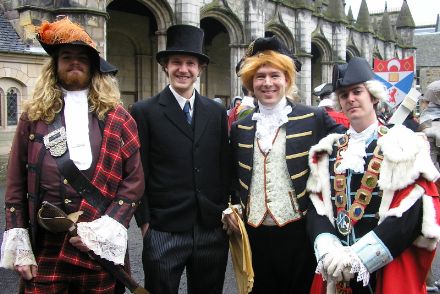
Once again it is Procession Day here in St Andrews, when we have the annual Kate Kennedy Procession to harken the return of springtime. Unfortunately, like last year, it was on the cold side and rather grey, despite some truly beautiful days previously.
For those of you who don’t know it, the Kate Kennedy procession is a medieval rite of spring which was resurrected in the past century. Kate Kennedy, according to lore, was the niece of Bishop James Kennedy, the founder of St. Salvator’s College. Owing to her beauty, a procession was held in spring in her honor, according to lore. Eventually, these became pretty rowdy, and as such were banned in the 19th century. In the 1920’s, Donald Kennedy, an indirect descendant of Bishop Kennedy himself, decided the resurrect the procession and founded the Kate Kennedy Club for this distinct purpose.
The Club admits nine new members each year from the bejant (first year) class. One of these is selected to portray the comely Kate Kennedy in the Procession, and is joined by the eight other bejants as sheild-bearers, and other students, members, and friends of the University who dress up as important figures from the history of town and gown. (more…)
A Good Week for Lectures
No one quite knows how often the Gifford Lectures are. Some people say they’re every three years. I thought they were every year, and they are spread amongst the four ancients of Scotland (St Andrews, Aberdeen, Glasgow, Edinburgh). But we hosted them in my first year and already have them again. And our own Professor John Haldane (alledgedly the only theist in the School of Philosophy) is concurrently giving the Gifford Lectures at Aberdeen, supposedly. Go figure.
Anyhow, on Tuesday commenced the ambigu-annual (ambiguennale, I am told, is the word the Italians use) Gifford Lectures here at St Andrews, by none other than the most-eminent Professor Alvin Plantinga of the University of Notre Dame. Unfortunately, I had to miss this one, as I had work to do. The title was ‘Evolution and Design’ and it basically demonstrated that there is no conflict between evolution (even Darwinian concepts of evolution) and the idea of design by the Creator as advocated by Christians.
Wednesday, I attended a lecture by Irving Lavin of Princeton University entitled ‘The Story of O from Giotto to Einstein’. It tracked the fascinating tale of Giotto’s ‘O’ from the perhaps aprocryphal tale all the way to an etching of Einstein, via calligraphy, Rembrandt, Jasper Johns, and others. Difficult to quite explain it, but most enlightening. Also, it was about an hour and a half but felt more like forty-five minutes.
Yesterday, I did attend, and Platinga demonstrated in his second Gifford Lecture that there is a conflict between the naturalist/materialist idea that the universe is a closed system because there is no demonstratable evidence of such, nor is it even observable. Thus science cannot really have anything to do with the idea of the closed universe, and it is left to metaphysics. So all the silly liberal posturing about the ridiculousness of miracles is, in effect, ridiculous itself, and most unscientific.
Thankfully, Professor Plantinga is a very good lecture, balancing clarity, thoroughness, joviality, and asides quite adroitly. The next is on Tuesday: ‘Evolutionary Psychology and Scripture Scholarship: more alike than you think’.
Tonight, I’m off to the theatre to see the late Arthur Miller’s ‘The Creation of the World and Other Business’. Apparently some sort of retelling of the Genesis narrative. A fellow son of the Empire State, second-year John MacDonald, is among the cast of this production. We look forward to it.
The Rites of Saturday Morning
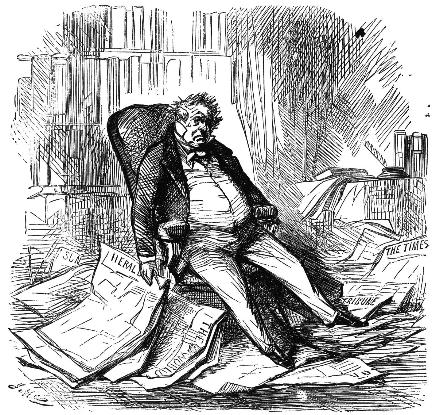
ORDER OF SERVICE
Entrance (silence)
(The officiant then organises the various sections of newspaper into the order in which they shall be read. Frivolities, such as ‘Gardening’, ‘Motoring’, and ‘Money & Business’, are discarded.)
First Reading: The Daily Telegraph, first section
Second Reading: The Financial Times, first section
First Glance: The Daily Telegraph, Weekend section (Rarely anything worth reading inside, but tradition requires at least a glance)
Third Reading: The Daily Telegraph, Property section
Nourishment: A sugar doughring from Fisher & Donaldson’s (Members of all newspaper-reading denominations are invited to partake, but are encouraged to abide by the rules of their respective communities)
Fourth Reading: The Financial Times, Weekend section (The best weekend section there is. Short and varied.)
Second Glance: The Daily Telegraph, Travel section (Ditto notes on Telegraph Weekend section)
Fifth Reading: FT Magazine
Final flip through the pages: (ruffle, ruffle, ruffle)
Exit. (The assembled then disperse and carry on with their day).
Rest in Peace
There are many wonderful things one might say about our late Holy Father, but most of it has been said already and better by others, so I will leave papal ponderings to your own discretion.
Something I found amusing, and then sad, and then amusing again was the following quote from CNN’s Christiane Amanpour:
Yeah, right. In reality (outside the potemkin village the secular media have built to fool the public as well as themselves), it goes more like this:
But therein lies what seperates their way of thinking from the Church’s.
Hat tip: OTR.
Greenwich Hospital
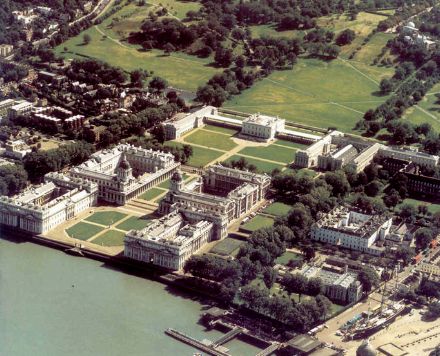
One of my favorite campuses (campii?) in the world is the Royal Hospital at Greenwhich. The site was originally home to the Palace of Placentia, a royal palace built by Humphrey, Duke of Gloucester in 1428. Placentia was the primary royal residence for two centuries up unto the Civil War, after which it fell into ruin. In 1694, the Royal Naval Hospital for Seamen was established as a home for old sailors, and grandiose architecture was required to show the monarchic splendor of a royal foundation. (more…)
Search
Instagram: @andcusack
Click here for my Instagram photos.Most Recent Posts
- Silver Jubilee November 21, 2024
- Articles of Note: 11 November 2024 November 11, 2024
- Why do you read? November 5, 2024
- India November 4, 2024
- The Lithe Efficiency of the Old Constitution November 4, 2024
Most Recent Comments
Book Wishlist
Monthly Archives
Categories


